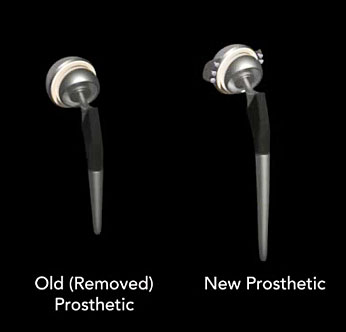
A hip replacement is a mechanical device with parts that are assembled before and during the operation, most commonly referred to as a “ball and socket.” After surgery, the prosthetic ball and socket restore movement in the hip during the life-span of the prosthesis. Current surgical techniques and hip replacement implants provide excellent clinical results and predictable long-term outcomes.
However, over time the original components of a Total Hip Replacement (THR) can break down and loosen from the bone surface they were once firmly attached. Revision Hip Replacement, also known as Revision Total Hip Arthroplasty, involves the exchange of some or all worn components with new ones. The degree of complexity for this procedure is dependent on the amount of loosening and associated damage to the underlying bone surfaces that may have occurred over time. Specialized components, bone graft and cement may be used to rebuild the hip joint.
Dr. Riddhivardhan will compare a series of your x-rays taken over many years to observe changes in implant position or the condition of the surrounding bone. Based on these factors, he will decide with you if a revision surgery is necessary.
A hip replacement can fail for the following reasons
- Wearing out of the artificial ball-and-socket joint – This releases tiny bits of plastic that can cause the joint to come loose from the bone.
- Infection in your hip replacement – Infection can make your hip replacement come loose from the bone.
- Fracture (break) of the femur (thighbone) around your hip replacement – This can happen if you fall heavily on your hip.
These problems can make it difficult for you to walk, and can sometimes cause pain. If your hip replacement is coming loose because of wear or infection, it will probably get more painful over time. The bone around a loose hip replacement can get thin and it may fracture. You will need to have a major surgery to fix the fracture and do your hip replacement again. If you have an infection in your hip replacement, it can spread to other artificial joints and vital organs.
The complexity of the operation depends largely upon which components of your hip replacement need to be removed.
Forms of revision hip replacement
- Total Revision – Where both the acetabular (cup) and femoral (stem) components of the hip have to be removed and replaced.
- Acetabular Revision – Where just the cup component is removed and replaced.
- Femoral Revision – Where just the stem component is removed and replaced.
All of these operations are technically demanding and take considerably longer to perform than a normal hip replacement. The length of the operation often depends upon how difficult it is to remove the original prosthesis and whilst Dr. Riddhivardhan will make an assessment of the estimated operating time prior to surgery, it is not always possible to establish exactly how complex the procedure will be until the operation is in progress. However, as a general guide an Acetabular revision usually takes less time than a Femoral revision whilst a Total revision procedure is the most complex of the three procedures.
The Revision Procedure
During hip revision surgery, Dr. Riddhivardhan will make an incision near the hip, enter the hip and take the hip out of socket. The bones and tissue about the hip will be carefully assessed. Dr. Riddhivardhan will check to see if the hip replacement parts are firmly fixed into the bone (stability) and check their positioning in the bone (alignment). One or more components of the artificial hip will be removed and replaced with new parts. Bone graft may be placed in bone and soft tissue (such as tendon and muscle) will be repaired as needed.
Tissue and/or fluid from the hip may be tested to see if an infection is present. If these tests show that the hip is infected, or if Dr. Riddhivardhan is highly concerned about infection, he may elect to remove the hip replacement and put a temporary “spacer” in its place instead of a new hip replacement. If this happens, the patient will likely need antibiotics for a number of weeks and will need to undergo additional surgery to have a new hip replacement put in place at a later date. Dr. Riddhivardhan specific course of action will determined at the time of surgery, based on his evaluation of the joint. The absence of any infection will require a single operation to replace the joint.
When the new prosthesis has been fitted the skin will be closed using stitches or clips. In some cases a small plastic tube is inserted near the operation area this is called a drain and allows any build up of fluid near the operation site to drain away in to a small plastic bag attached to the end of the tube. The drain will be removed on the ward approximately two days after the operation. A dressing will be applied over the wound site

The revision procedure requires mastery of difficult surgical techniques to achieve good results. Dr. Riddhivardhan specialises in very difficult revision operations where patients have often been told that further surgery is not possible.
